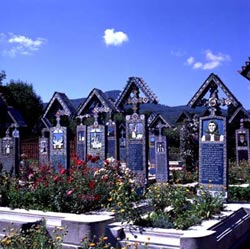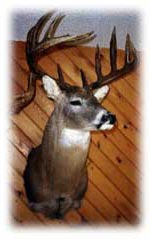Maramures
The Maramures county, situated at the Northern border of Romania with Ukraine, consists in the old "lands" of Maramures, Chioarul, Lapus and Baia Mare Depressions.
Thanks to its richness in gold, silver, lead, copper, salt, its large pastures and natural hay fields, forests and agricol fields, its fauna and flora, this county was inhabited many millenaries ago.
The municipality of Baia Mare is the capital city of this county. Now, the population consists in Romanians (81 percent), Magyars (10.5 percent), Ukrainians (6.8 per cent), Gypsies (1.3 per cent),Germans (0.6 per cent) a.o.
|
 |
Of this surface of 6,215 sq. km, 43 per cent is a mountain zone with the Rodna Mountains and their Pietrosul Massif (2.303 m) - the highest one in the Oriental Carpathians and volcanic zones with the Gutai and Jibles Mountains (1.300 up to 1.800 m above sea); 30 per cent are hills, plateaus and piedmonts and 27 per cent are depression, meadows and terraces. In the middle of the Maramures, Rodna, Gutai and Tibles Mountains there is the Maramures Depression, the largest one in Romania (75 km long and 20 km wide). Up the mountains the winter reigns till May-June. The picturesque lakes situated near by the town of Baia Sprie are visited thanks to their beauty: Bodi-Ferneziu, Bodi-Suior, Nistru Lakes, the Blue Lake, the man-made lake of Firiza.The picturesque lakes situated near by the town of Baia Sprie are visited thanks to their beauty: Bodi-Ferneziu, Bodi-Suior, Nistru Lakes, the Blue Lake, the man-made lake of Firiza.
Characteristically to this county of Romania are the hydromineral sources (over 100 springs) especially the ones near by Baia Borsa, Viseu de Sus. Baiut and Poiana Botizii.
The Maramures county has 62 hunting grounds with a surface of 587,000 ha. There are also eight zones of natural reservation.
The county is rich in ethnographic and folk elements. The folk art is preserved here as a very original form: houses, gates in wood, tools, textures, pottery, churches built in wood uniqually in the world, distinct customs.
The Maramures county has its gates opened to the tourists who want to know its original folk culture: the museums in Baia Mare and Sighetu Marmatiei ; over 200 monuments of folk architecture, the Borsa, Izvoarele and Mogosa Spas. Very original are also the villages situated on the Iza, Mara, Viseu and Tisa Valleys, forming real open-air museums. Unique in the world is the Merry Graveyard from the village of Sapanta.
In this county there are eight museums, 67 historical monuments and sites, 363 architectural monuments and piles as well as 13 historic zones in towns and villages.
The wooden churches in Maramures
In a rich country, blessed with forests, the wood offers the possibility for everyone to become artists. The wooden churches with their tall and pointed steeples, are representative especially for the landscape in Maramures si Salaj.
Not far away from Sighetul Marmatiei (where there is an open air museum exhibiting the traditional architecture of Maramures) we find Sapânta, a village renown for its Cimitirul Vesel (Merry Cemetery) - which, according to an American classification is the second in the world in point of the funeral monuments, after the Valley of the Kings. The cemetery is characterised by the coloured wooden crosses with human faces and symbols sculpted near comical verses. The master sculptor Ion Stan Patras, who created this death carnival, is also buried here.
The region Salaj is considered a miniature Switzerland, at least in point of its landscape beauty, with mountains and valleys, with villages characterised by beautifully carved gates and impressive house-holds, such as Fildu de Sus, Fildu de Mijloc, Sânmihaiu Almasului, Hida, Jac si Moigrad, Sârbi, Rastoltu Mare sau Pausa. The tourist can also see wooden churches dating from the 17 - 18 centuries, many of them built of common oak wood - and this is why they are not so high as those built of fir wood. Many of these churches are richly adorned both in th einside and on the outside.
All through the centuries, people have built watchtowers inside the tall steeples in order to see from great distance the appearance of floods, fires or the invading attacks of the enemies.
The extremely high roofs and the arrow-like steeples made the specialists talk about the "Gothic style of Maramures" and to search for the reasons for which these impressive places and structures were chosen for.
THE MERRY CEMETERY
Sapânta, a village in the ancient region of Oas, is famous because of its Merry Cemetery, one of the biggest attractions world-wide, no 1 in Europe among funeral monuments and no 2 in the world after the Valley of Kings, Egypt. The crosses are carved in wood by local artists. The inscriptions and colorful drawings are a humorous illustration of the lives of deceased people. |

